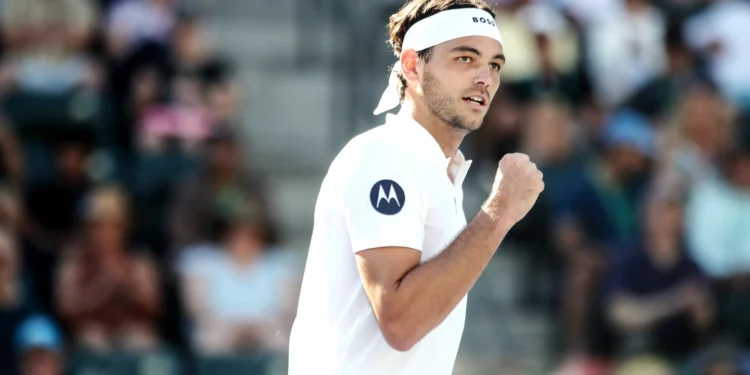What’s Next For Taylor Fritz?
Top American man says he wants to beat Sinner, Alcaraz, Djokovic
It’s an oddity of tennis that, more often than not, the loser of a match is not interviewed immediately afterwards. So Taylor Fritz didn’t get to discuss his recent loss to Denis Shapovalov in Dallas until the media day of the next event he played– The Delray Beach Open.
There, remarkably, Fritz had total recall of minutiae: “He played a very good game to break me in the second set. I had two break points to get back, both times he hit balls just barely catching the line to save the break points, then served incredibly well in the 3rd set. I had love-30 at 4-5 and 3 second serve points in a row, and that was my opportunity…” This goes on.
A few things here. Fritz obviously has a crackerjack of a working memory. He says his mind keeps a “notepad.” Secondly, he’s a bit hard on himself. I checked– Shapo, a lefty, hit a spin-and-speed mix of three exceptional serves on those points.
A little about Fritz, before we get to his game. An admitted introvert, he’s intelligent, analytical and opinionated. If you ask him a question, he’ll do his level best to answer straightforwardly, without agendas. He gives his work life everything he’s got, then in his precious few moments of downtime, allows himself fast food and video games. Raise your hand if you can relate.
His belief in himself appears to be an ascending work in progress. He says the U.S. needs a new men’s Grand Slam champion and “among the group we have, I really want to be the one to do that.”
But can he?
What Is Taylor Fritz’s World Ranking?
Ranked a career-high #4 in the world, Fritz made his first Grand Slam final at last year’s U.S. Open. He’s got the guy just ahead of him, Alexander Zverev, basically figured out. He’s won 5 of their last 6 meetings. That leaves Jannik Sinner, Carlos Alcaraz– and the GOAT Novak Djokovic. Garden-variety losses on tour happen, but he says “it is just those guys” that he feels he needs to work especially hard to crack.
The question is, to accomplish that, does he spend his time sharpening and leaning into what he does well, like serving, or does he need to make meaningful changes in other areas to beat Sinner, Alcaraz and Djokovic?
Let’s take a look at some stats.
Can Taylor Fritz Beat Sinner, Alcaraz and Djokovic?
Among the serving and returning categories, something jumps out. Fritz has improved dramatically in all of the major serve categories in the past year.
Career 1st Serve In% = 60%
Past Year 1st Serve In% = 63%
Career 1st Serve Points Won% = 76%
Past Year 1st Serve Points Won% = 79%
Career 2nd Serve Points Won% = 52%
Past Year 2nd Serve Points Won% = 56%
Career Service Games Won% = 84%
Past Year Service Games Won% = 89%
These are fairly stunning increases when you consider that the career numbers encompass the past year. But there’s more. His percentages in all the major returning categories haven’t budged. His numbers in the past year are incredibly stable when compared to his career, sometimes to the decimal point.
So there are a few takeaways from all that. For starters, we know his winning starts with his serve and probably what he does after the serve, namely his forehand. Secondly, we know exactly where he has room to grow: His return game. Fritz must sense it, because that’s where he was critical of himself in the loss to Shapo.
The eyeball test tells us Fritz has also improved his movement and his mental toughness. The anecdotal evidence: A grueling 5-set semifinal win over Francis Tiafoe in last year’s US Open in front of a sellout crowd.
Here’s the deal. Fritz is a collective 1-16 against Sinner, Alcaraz and Djokovic. The matches are almost always straight set losses, even if the sets are close. Simply making incremental improvements to his return game might not be enough.
Taylor Fritz’s Net Game
At 6’5”, you’d think improving his net game would be the obvious answer. Let’s be clear: That has not been a meaningful part of his progress so far. According to Australian Open data via Infosys, from 2019-2023, Fritz approached the net an average of 4.7 times per set. At this year’s U.S. Open and Australian Open, his average was 5.5. The dude just doesn’t like to approach the net unless it’s a sure thing. And remember– his serve has improved, so theoretically there would have been even more short balls on which to approach. But no.
Fritz either doesn’t have the time to address this part of his game right now, or it’s simply not in his DNA. So what about other aspects? Since he says he enjoys the study of patterns, I asked him about his steadfast, almost stubborn predilection for taking his backhand cross-court.
Q: You like to play backhand cross with a discipline that has taken you to #4 in the world. To beat Alcaraz and Sinner, do you ever think of changing up the patterns that are comfortable and your go-to patterns?
A: It just depends on the surface, the balls, the speed of the court. If it’s in a slow condition, I can’t go backhand line to those guys because they’ll run over, and they’ll hurt me. It won’t generate enough. If it’s a faster condition, I will look to come out of that rally, be a bit more aggressive, because the backhand line, the risk of that will actually be worth it.
Someone like Carlos, backhand-to-backhand’s a bit better for me. With Jannik? Definitely mix up the patterns a bit more, maybe work with my forehand a bit more. A lot of it depends on how fast the court is, how fast the conditions are, if taking those risks are worth it or not.
As you can see, patterns are something Fritz considers in great detail. “I’m definitely micromanaging all these little thoughts,” he says.
Hitting backhand down the line, running around his backhand to hit his incredibly powerful forehand and approaching the net more are all within the realm of areas for Fritz to explore to grab those handful of extra points against Sinner, Alcaraz and Djokovic. But he seems to indicate his return of serve, especially pouncing on second-serve opportunities, is top of mind.
How far Fritz can go depends on a number of factors including how he handles the success he’s earned– as well as his appetite for change.
“I’ve just been consistently improving bit by bit every year, so hopefully I can keep moving in that direction,” Fritz said. “Because it’s close.”
















